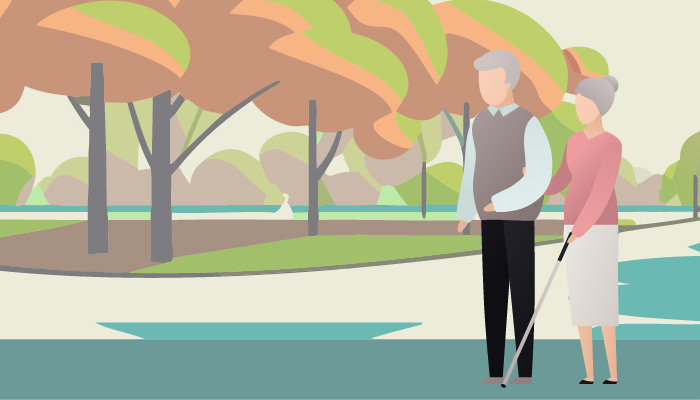
If the person you care for has a low-vision diagnosis, you are likely concerned about their ability to orient themselves and learn to move safely without falling or becoming injured.
Many people with low vision rely on the assistance of a “human guide.” You may already serve in that function for your loved one. Perhaps your relative also uses a cane. A cane gives them extra information about the environment. It also signals their impairment to others, increasing the chances for consideration and reducing the risk of their getting jostled.
Here are some tips for being an effective human guide:
- Walk one half step ahead of your relative. Have them grasp the back of your arm, just above the elbow, using the hand that is not holding a cane. By following a bit behind you, they have more lead time to react to obstacles or changes.
- Let your loved one set the pace to slow down or speed up. Maintain awareness of obstacles that are to the side where your relative is walking (consider yourself “extra wide”). Steer your loved one clear. Periodically look back to confirm that they seem to be comfortable with the journey.
- Announce upcoming changes, such as “stairs up” or “curb down.” Stop when you are close to the edge. Approach the edge straight on (perpendicularly) rather than at an angle. This will make it easier for your relative to judge the distance before the change. Step down/up one step and let your relative feel the edge with their toes before moving forward. If there’s a handrail, position your relative so it’s on the side of their free arm. You may want to stop and lift their free hand to the rail before continuing.
- In narrow passageways, place your forearm behind your back. This signals your loved one to get in single file and shift their grip down to your wrist. Once through the passageway, shift your forearm to facing forward again, and they can move back to their half-step-behind position.
- Never leave your relative in the middle of an open area—indoors or outside—with no furniture, wall, or other landmark to orient themselves.
Orientation and mobility specialists can teach your loved one the strategies they need to independently cope with the environments they encounter. Ask the doctor for a referral. Call to confirm that the services are covered by Medicare.

